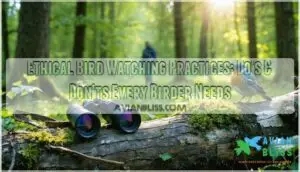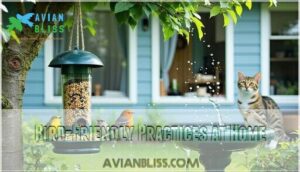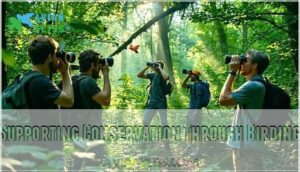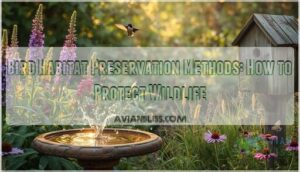This site is supported by our readers. We may earn a commission, at no cost to you, if you purchase through links.

You’ll want to maintain safe distances from birds, typically 15-25 feet, to avoid causing stress or disrupting natural behaviors.
Don’t use loud playback calls or pishing sounds that can confuse birds during breeding season.
Stay on designated trails to protect sensitive vegetation, and never approach nests or attempt to move birds for better photos.
Keep your cat indoors, as outdoor cats kill billions of birds annually.
Think of yourself as a respectful guest in their home, following responsible birding techniques and maintaining safe distances to avoid causing stress or disrupting natural behaviors, all of which form foundational principles.
Table Of Contents
- Key Takeaways
- Importance of Birding Ethics
- What Are Ethical Bird Watching Practices
- Minimizing Disturbance to Birds
- Bird-Friendly Practices at Home
- The Code of Birding Ethics
- Dealing With Unethical Birding Behavior
- Responsible Bird Photography
- Supporting Conservation Through Birding
- Frequently Asked Questions (FAQs)
- What are the 5 S’s of birding?
- What is the etiquette for birding in Audubon?
- How do you ethically have a pet bird?
- What are the ethics of using bird calls?
- What is Birding Ethics?
- What are the ethical guidelines for birdwatching?
- What is Birds Canada’s Code of Birding Ethics?
- How do you deal with perceived unethical birding behavior?
- What is the Code of ethics for birders?
- How to be a good bird watcher?
- Conclusion
Key Takeaways
- Keep your distance and minimize disturbance – You’ll want to stay 15-25 feet away from birds, avoid excessive playback calls during breeding season, and watch for stress signals like alarm calls or frantic movements that indicate you’re too close.
- Protect habitats by staying on designated trails – You shouldn’t wander off-path, since trampling vegetation destroys nesting sites and feeding areas that birds depend on for survival, and your footsteps can cause lasting damage to fragile ecosystems.
- Make your home bird-friendly – You can prevent billions of bird deaths annually by keeping cats indoors, installing window decals to prevent collisions, and maintaining clean feeding stations positioned safely away from predators.
- Practice responsible photography and sharing – You shouldn’t use baiting, luring, or get too close to nests for photos, and when sharing rare bird sightings online, avoid posting exact locations to prevent habitat disruption from crowds of visitors.
Importance of Birding Ethics
When you observe birds in their natural habitat, your actions directly affect their survival, breeding success, and overall well-being.
Every moment you spend in the field shapes the future of the birds you love to watch.
Following ethical birding practices protects vulnerable species, supports conservation efforts, and maintains the reputation of the birding community as responsible stewards of wildlife.
Impact on Bird Populations
Irrespective bird watching practices create ripple effects that contribute to population decline across vulnerable species.
When birders ignore ethical guidelines, they cause habitat disturbance that disrupts breeding success and increases stress levels in local populations.
These disturbance effects compound existing threats like habitat loss and climate change.
Your actions matter—every decision you make in the field either supports or undermines bird conservation.
Practicing ethical bird watching practices helps protect bird populations from unnecessary human-induced pressures that threaten their survival.
Role in Conservation Efforts
Your ethical birding choices directly fuel bird conservation and birdwatching conservation efforts nationwide.
When you follow proper birdwatching ethics, you’re contributing to a movement that protects avian species through multiple channels.
Consider how your actions support conservation:
- Citizen Science participation – Your eBird submissions and Christmas Bird Count data inform Species Monitoring programs that track population trends
- Habitat Preservation advocacy – Ethical birders often champion Policy Advocacy for protected areas and migration corridors
- Funding Conservation initiatives – Responsible birders frequently donate to organizations conducting essential research and restoration projects
These conservation efforts create lasting impacts for future generations of both birds and birders.
Birding Community Reputation
Your ethical birding behavior shapes how the entire birdwatching community appears to outsiders.
When you follow birding ethics, you’re protecting our collective birding image from those who might view us as disruptive.
Responsible reporting of rare sightings without revealing exact locations demonstrates conservation advocacy.
Poor ethical enforcement within our ranks damages community perception.
Think of yourself as an ambassador—your ethical birding practices represent thousands of fellow birders who share your passion.
What Are Ethical Bird Watching Practices
Understanding the foundation of responsible birding starts with recognizing what ethical birdwatching practices actually look like in the field. These principles form the backbone of respectful birding and guarantee bird welfare remains your top priority.
- Habitat Protection: You’ll want to stick to designated trails and avoid trampling vegetation. Think of yourself as a visitor in their home—you wouldn’t rearrange someone’s furniture, right? This approach supports conservation efforts while maintaining legal compliance.
- Minimize Disturbance: Keep reasonable distances from birds and resist the urge to get that perfect close-up shot. Your binoculars are your best friend here, allowing clear observation without stress.
- Conservation Support: Every ethical choice you make contributes to broader bird conservation initiatives and strengthens the birdwatching community’s reputation.
Minimizing Disturbance to Birds
You can substantially impact bird behavior and survival by understanding how your presence affects their natural routines, feeding patterns, and breeding activities.
When you maintain proper distances, avoid using artificial calls, and recognize stress signals like alarm calls, you create a safer environment that allows birds to carry out essential behaviors without unnecessary energy expenditure or abandoning critical activities like nest care.
Maintain proper distances, avoid using artificial calls, and recognize stress signals like alarm calls.
Safe Viewing Distances
Watching birds behave naturally requires keeping your distance—think personal space, but for wildlife.
Use binoculars to observe Stress Indicators like rapid head movements or alarm calls. Your Binocular Choice matters; quality optics let you maintain proper spacing while still capturing details.
Consider using specialized birding binoculars for enhanced viewing.
Habitat Sensitivity varies by location, so adjust your Approach Techniques accordingly. Practice responsible birding by respecting each species’ comfort zone.
Avoiding Playback and Pishing
Playing recorded bird calls might feel like opening a direct line to nature, but playback ethics demand restraint.
These audio lures can stress birds by mimicking territorial threats, forcing them to waste precious energy defending nonexistent rivals.
Species sensitivity varies dramatically—some tolerate occasional calls while others abandon nests entirely.
Call overuse in popular birding spots creates chronic disturbance.
For disturbance minimization, consider these alternative methods:
- Practice patient observation without artificial stimuli
- Learn natural bird identification through field guides
- Focus on habitat restoration to attract birds organically
Recognizing Alarm Calls
Learning bird body language beats using playback recordings every time.
When you spot frantic flapping, rapid chirping, or harsh chattering, you’re witnessing alarm calls that signal danger. These behavioral changes help with species identification and predator detection while following birdwatching ethics.
| Alarm Call Types | What It Sounds Like | Bird’s Message |
|---|---|---|
| Sharp chips | Quick "chip-chip-chip" | Ground predator nearby |
| Harsh scolds | Loud chattering | Nest under threat |
| Mobbing calls | Continuous alarm chorus | Group defense mode |
| Freeze calls | Single sharp note | Everyone stay still |
| All-clear calls | Soft, musical notes | Danger has passed |
Recognizing these signals helps minimize disturbance and supports ethical birding practices.
Staying on Designated Trails
Beyond simply following trail etiquette guidelines, staying on designated paths serves as your frontline defense for habitat protection.
When you wander off-trail, you’re inadvertently contributing to erosion prevention challenges and plant conservation issues. Trampling fragile vegetation disrupts nesting sites and feeding areas that birds depend on.
By minimizing impact through proper trail maintenance practices, you’re upholding essential bird watching ethics. This ethical birding approach guarantees birdwatching guidelines support habitat preservation while helping minimize disturbance to wildlife communities for future generations.
Bird-Friendly Practices at Home
You can transform your home into a bird sanctuary by implementing simple practices that protect local bird populations from common household hazards.
These changes, from keeping cats indoors to preventing window collisions, create safer environments while supporting the conservation efforts you practice in the field.
Keeping Cats Indoors
Your indoor cat becomes a wildlife hero by staying inside.
Cat predation devastates bird populations—outdoor cats kill billions annually.
Create indoor enrichment with climbing towers, puzzle feeders, and window perches.
Consider leash training for supervised outdoor time.
This ethical practice protects bird habitats while keeping your feline safe from traffic and disease.
Community education spreads these bird conservation efforts.
Preventing Window Strikes
Beyond keeping cats indoors, you’ll need to tackle window strikes – a sneaky killer that claims millions of birds annually.
Birds can’t see glass and mistake reflections for open sky. Decal effectiveness improves when you place them on the outside, breaking up those tricky reflections.
For effective prevention, consider purchasing window decals. Consider glass options like bird-safe varieties or external screens for high-risk windows.
Smart feeder placement away from windows reduces collision risks. DIY solutions include shade cloths or partially closed blinds.
These bird conservation tips and birdfriendly practices help protect bird habitats while prevent bird collisions effectively.
Maintaining Safe Feeding Stations
Beyond window safety, your feeding station becomes a vital hub for bird health when properly maintained. Smart feeder hygiene and strategic placement protect visiting birds while supporting bird conservation tips. Ensuring optimal feeder cleanliness is key to preventing disease.
Here’s your essential maintenance checklist:
- Clean feeders weekly with diluted bleach solution to prevent disease spread
- Position stations 3-10 feet from cover for quick escape routes
- Install predator deterrents like baffles to keep cats and hawks away
- Rotate food safety by removing moldy or wet seed immediately
Location matters tremendously for successful bird habitats and proper birdwatching etiquette.
Reducing Climate Change Impacts
Reducing your carbon footprint doesn’t require drastic lifestyle changes—small shifts make meaningful differences for bird conservation and environmental protection.
- Energy Conservation: Unplug electronics and switch to LED bulbs to cut emissions that affect bird habitats
- Waste Reduction: Compost kitchen scraps and recycle materials to minimize landfill contributions
- Native Planting: Choose indigenous plants that support local bird populations while requiring less water and fertilizer
The Code of Birding Ethics
You’ll find that most birding organizations follow a standard code of ethics that prioritizes bird welfare above all else, much like how doctors follow the Hippocratic Oath.
These guidelines establish four core principles: respecting birds and their habitats, respecting fellow birders, following all applicable laws, and sharing your observations responsibly with the birding community.
Respect for Birds and Habitat
Habitat preservation forms the cornerstone of responsible birding, demanding unwavering commitment to bird welfare and ethical conduct.
You’ll protect bird habitats by maintaining safe distances from sensitive areas, especially avoiding nesting birds during breeding seasons.
Sustainable birding means staying on designated trails, minimizing your footprint, and never disturbing natural vegetation.
When practicing ethical bird photography, resist the urge to get closer shots that might stress wildlife.
Your conservation advocacy begins with respecting these spaces—remember, you’re a guest in their home, not the landlord.
Respect for Fellow Birders
Treating fellow birders with courtesy strengthens our community and enhances everyone’s experience.
Your ethical practices and responsible behavior set community standards that others follow.
Practice proper trail etiquette by keeping noise levels low and managing group size appropriately.
When guiding others, share knowledge generously while respecting personal space.
Scope sharing creates opportunities for connection, but don’t monopolize prime viewing spots.
- Form orderly lines at popular birding locations to guarantee everyone gets viewing opportunities
Respect for The Law
Understanding birdwatching regulations keeps you out of trouble.
Always secure permits required for protected areas and respect private property boundaries. Conservation laws exist for good reasons, and hunting regulations might overlap your birding spots.
Think of legal compliance as your birding insurance policy.
| Legal Aspect | What to Check | Consequence |
|---|---|---|
| Restricted Areas | Park closures, seasonal limits | Fines, removal |
| Private Property | Owner permission, posted signs | Trespassing charges |
| Protected Areas | Special permits, group limits | Legal penalties |
| Hunting Regulations | Season dates, safety zones | Safety risks |
Sharing Observations Responsibly
Share your bird discoveries thoughtfully to protect vulnerable species and support conservation.
Your observations fuel citizen science, but location sensitivity matters when posting rare sightings online:
- Avoid geotagging sensitive nesting areas to prevent habitat disruption
- Practice data privacy by withholding exact coordinates of threatened species
- Consider image ethics before sharing photos that reveal specific locations
Responsible birdwatching and social media sharing prevents oversharing risks.
Dealing With Unethical Birding Behavior
You’ll occasionally encounter birders who chase rare species too aggressively, use excessive playback, or disturb nesting sites for that perfect photograph.
When you witness these situations, you can address them through gentle education, direct communication when appropriate, or reporting serious violations to park authorities and birding organizations, which may involve direct action to protect the birds.
Addressing Incidents Sensitively
When you witness questionable behavior in the field, take a deep breath before diving into confronting unethical behavior.
Your approach sets the tone for successful conflict resolution strategies and community dialogue.
| Do This | Avoid This |
|---|---|
| Use calm, friendly tone | Accusations or lecturing |
| Ask questions first | Public embarrassment |
| Share your own learning experiences | Demanding immediate compliance |
| Offer educational resources | Aggressive confrontation |
Start conversations with genuine curiosity about their perspective.
Most birders genuinely care about birdwatching ethics but may lack awareness of proper ethical practices.
Frame discussions around shared love for birds rather than birdwatching responsibility violations, making education feel collaborative.
Reporting Unethical Behavior
When you spot unethical behavior, don’t just watch—act.
Document everything through incident documentation: time, location, specifics.
Most reporting channels accept anonymous tips if anonymity concerns worry you.
Contact park rangers, birding organizations, or follow ABA Code of Birding Ethics guidelines.
Your evidence gathering and follow-up actions protect birds and maintain birdwatching ethics standards for everyone’s benefit.
Educating Others on Ethics
Beyond reporting incidents, you can help grow ethical awareness throughout the birding world.
Community Workshops offer perfect venues for discussing birdwatching ethics with fellow enthusiasts.
Share your knowledge through Mentorship Programs where experienced birders guide newcomers in ethical birding practices.
Youth Education initiatives spark conservation passion early, while Online Resources extend your reach to distant birders seeking guidance.
Social media becomes your platform for Ethical Advocacy, helping promote bird awareness through respectful examples.
Birdwatching education spreads naturally when you weave ethics into casual conversations, creating ripple effects that strengthen birdwatching awareness across entire communities.
Responsible Bird Photography
When you’re photographing birds, you’ll need to balance getting that perfect shot with respecting the bird’s natural behavior and habitat.
Your camera shouldn’t become a tool that causes stress or disrupts nesting sites, feeding routines, or normal daily activities that birds depend on for survival.
Respecting Nesting Sites
Addressing unethical behavior teaches moments, but photographing nesting birds requires extra care.
Ethical bird photography means maintaining proper nesting distance to avoid habitat impact. Watch for disturbance signs like agitated calls or defensive postures. Respect wildlife by never approaching active nests, even for that perfect shot.
Follow these photography ethics guidelines:
- Observe from afar – Your telephoto lens captures beauty without causing birdwatching disturbance
- Skip the close-up – Avoid nesting birds completely during breeding season
- Document responsibly – Reporting nests helps conservation efforts
- Prioritize their peace – Nesting sites deserve our utmost respect
Avoiding Baiting and Luring
Protecting nesting sites connects directly to avoiding artificial attraction methods that compromise bird welfare.
Baiting and luring manipulate natural behavior through artificial food sources or recordings, creating dependency and stress.
These practices violate birdwatching ethics by prioritizing human convenience over habitat integrity.
| Harmful Practices | Ethical Alternatives |
|---|---|
| Using live mice as lures | Rely on natural attraction |
| Playing recorded calls | Practice playback avoidance |
| Posting exact locations | Share general areas only |
| Crowding bird subjects | Maintain responsible observation |
Ethical photography means respecting bird behavior naturally.
Prioritizing Bird Well-being
Three fundamental principles guide ethical bird photography: minimize stress, respect natural behaviors, and maintain safe distances.
Your camera should never compromise bird welfare or disrupt feeding patterns.
Habitat protection becomes your conservation priority when you choose telephoto lenses over intrusive approaches.
These ethical decisions reflect core birdwatching ethics that prioritize wildlife needs over perfect shots.
Following these ethical guidelines guarantees your birdwatching dos and donts support long-term bird welfare rather than temporary photography goals.
Supporting Conservation Through Birding
Your birding activities can directly contribute to conservation efforts through citizen science projects, habitat restoration work, and supporting organizations that protect bird populations.
When you participate in programs like eBird or Christmas Bird Counts, you’re providing valuable data that researchers use to track population trends and identify species at risk.
Contributing to Bird Conservation Efforts
Moving from capturing birds through your lens to actively protecting them requires hands-on commitment.
Your conservation efforts create lasting impact beyond individual sightings.
- Support Conservation Funding through monthly donations to organizations like Audubon Society or local bird clubs.
- Engage in Policy Advocacy by contacting representatives about habitat protection legislation.
- Practice Habitat Restoration by planting native species in your yard.
- Join Citizen Science projects like eBird for birdwatching conservation efforts.
Volunteering for Birding Projects
Beyond personal contributions, volunteering in birding projects connects you directly with conservation efforts that make a real difference.
You’ll participate in citizen science through data collection and species monitoring activities that researchers actually use. Whether you’re helping with habitat restoration or engaging your community in birdwatching, these volunteer opportunities turn your passion into measurable impact.
Bird Surveys
Habitat Restoration
Nest Monitoring
Every volunteer hour strengthens bird conservation initiatives nationwide.
Spreading Awareness on Birding Ethics
Spreading awareness about birding ethics creates ripple effects that strengthen conservation efforts worldwide.
When you share knowledge about ethical practices, you’re building bridges between experienced birders and newcomers who need guidance on respecting bird habitats and bird behavior.
Here are three powerful ways to amplify your impact:
- Lead Educational Workshops at local nature centers, teaching proper birdwatching techniques and habitat protection
- Use Social Media platforms to showcase responsible birding moments and ethical decision-making
- Champion Conservation Advocacy through Community Engagement and Citizen Science projects that document bird populations
Frequently Asked Questions (FAQs)
What are the 5 S’s of birding?
Nearly 45 million Americans watch birds, yet many don’t know the fundamental 5 S’s.
You’ll master birding basics through: See (observe carefully), Sit (remain still), Silence (stay quiet), Slow (move deliberately), and Steady (maintain patience while watching).
What is the etiquette for birding in Audubon?
You’ll follow Audubon’s core principles: maintain respectful distances from birds, avoid using playback calls excessively, stay on designated trails, never disturb nests, and prioritize bird welfare over getting that perfect photo.
How do you ethically have a pet bird?
Like adopting a feathered family member, you’ll need proper veterinary care, spacious housing, species-appropriate diet, daily social interaction, and mental stimulation.
Research your bird’s specific needs before committing to this lifelong responsibility.
What are the ethics of using bird calls?
You should use bird calls sparingly and responsibly.
Limit playback to brief sessions, avoid breeding season, and stop immediately when birds respond.
Excessive use wastes their energy and disrupts natural behaviors.
What is Birding Ethics?
While some chase rare birds for personal glory, birding ethics puts bird welfare first.
You’ll respect their habitats, maintain safe distances, avoid playback abuse, and follow conservation guidelines that protect species for future generations.
What are the ethical guidelines for birdwatching?
Maintain respectful distances from birds to avoid stress.
Don’t use playback calls excessively.
Stay on designated trails to protect habitats.
Keep cats indoors and prevent window strikes to support conservation efforts.
What is Birds Canada’s Code of Birding Ethics?
Birds Canada’s Code emphasizes putting bird welfare first, keeping respectful distances, avoiding playback overuse, staying on designated trails, and sharing observations responsibly while protecting sensitive nesting locations from disturbance.
How do you deal with perceived unethical birding behavior?
Gently guide guilty parties toward proper practices.
You’ll find friendly conversation works better than confrontation.
Share knowledge about bird welfare, suggest alternatives, and model respectful behavior.
Remember, we’re all learning together in this birding community.
What is the Code of ethics for birders?
You’ll follow birding’s golden rule: prioritize bird welfare above all else.
Keep respectful distances, avoid disturbing nests, limit playback use, stay on trails.
And share sightings responsibly without revealing sensitive locations, to ensure the well-being of the birds, following the principle of bird welfare.
How to be a good bird watcher?
Want to discover nature’s secrets? Keep quiet, move slowly, and respect wildlife’s space.
Use binoculars, stay on trails, and avoid disturbing nests.
Share sightings responsibly while protecting sensitive locations from crowds.
Conclusion
Remember when town criers announced important news? Today, you’re the messenger spreading awareness about ethical bird watching practices.
You’ve learned to maintain proper distances, avoid disruptive sounds, and respect nesting sites. By following these guidelines, you’ll protect bird populations while enjoying meaningful observations.
Your commitment to responsible birding helps preserve habitats for future generations. Share your knowledge with fellow birders, support conservation efforts, and continue practicing these ethical principles.
Every respectful action you take makes a difference in protecting our feathered friends.
- https://www.massaudubon.org/places-to-explore/activities/birds-birding/birding-code-of-ethics
- https://canopytower.com/birding-ethics-and-etiquette/
- https://www.threeriversparks.org/blog/birding-etiquette-and-how-be-ethical-birder
- https://ebird.org/region/US-OR/post/birding-ethics-guidelines-for-respecting-birds-their-habitat-and-each-other
- https://ecbirds.org/birder-resources-2/code-of-birding-ethics/















